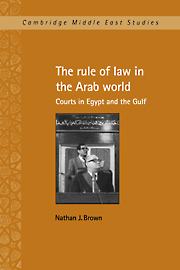Book contents
- Frontmatter
- Contents
- Preface
- Glossary
- 1 Arab courts in comparative perspective
- 2 The creation and operation of the modern Egyptian legal system, 1876–1937
- 3 Egyptian courts., 1937–1971: centralization, authoritarianism, and socialism
- 4 Egyptian courts, 1971–1996: the reemergence of liberal legality
- 5 Legal reform in the Arab states of the Gulf
- 6 The legal system and the rule of law in Kuwait and Qatar
- 7 Popular uses of the courts
- 8 Business and the courts
- Conclusion
- Bibliography
- Index
3 - Egyptian courts., 1937–1971: centralization, authoritarianism, and socialism
Published online by Cambridge University Press: 23 October 2009
- Frontmatter
- Contents
- Preface
- Glossary
- 1 Arab courts in comparative perspective
- 2 The creation and operation of the modern Egyptian legal system, 1876–1937
- 3 Egyptian courts., 1937–1971: centralization, authoritarianism, and socialism
- 4 Egyptian courts, 1971–1996: the reemergence of liberal legality
- 5 Legal reform in the Arab states of the Gulf
- 6 The legal system and the rule of law in Kuwait and Qatar
- 7 Popular uses of the courts
- 8 Business and the courts
- Conclusion
- Bibliography
- Index
Summary
In the three decades following the Montreux conference the most striking feature of the Egyptian judicial structure was its institutional continuity. The few major changes that were made (with the possible exception of the establishment of the Majlis al-Dawla) had the effect of furthering the centralization of the system. What makes this continuity especially noteworthy was that it coincided with tremendous political changes in the country. The battles between the Wafd, the British, and the king, the end of the constitutional monarchy, and the establishment of an authoritarian and socialist regime under Gamal 'Abd al-Nasir caused significant changes in the political role of the judiciary without altering its basic structure. Only in the last few years of 'Abd al-Nasir's rule were more fundamental changes discussed, and only some of these were effected. For the most part, dramatic political changes in the country were accommodated by seemingly minor changes in the judicial structure. The periods both before and after the 1952 coup, which replaced the parliamentary monarchy with rule by army officers, witnessed further centralization of the judicial system. This coincided with an attempt to entrench further liberal legality. The attempt realized some successes, but within a few years after 1952 these successes, though formally institutionalized, were effectively reversed.
The unification of the judiciary
The agreement at Montreux to end the capitulations and to transfer the work of the Mixed Courts to the National Courts after a twelve-year period finally made possible the unification of the judicial structure anticipated by Nubar and others in the 1870s. With the Mixed Courts seen as an anachronistic limitation on Egyptian sovereignty, they were allowed to disappear completely.
- Type
- Chapter
- Information
- The Rule of Law in the Arab WorldCourts in Egypt and the Gulf, pp. 61 - 92Publisher: Cambridge University PressPrint publication year: 1997
- 1
- Cited by



